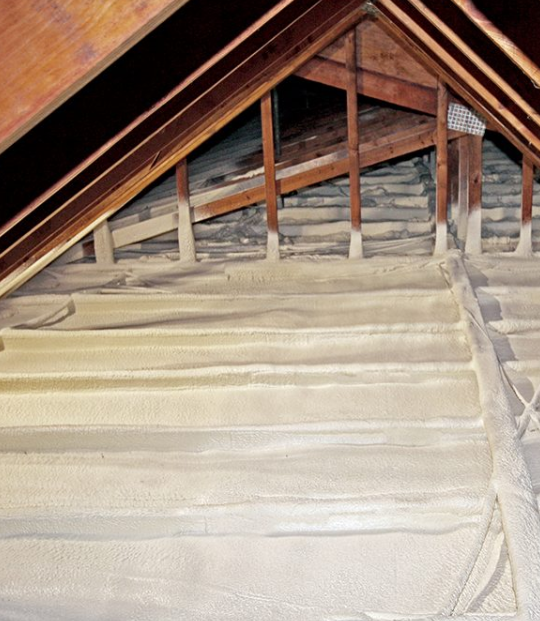How Does Spray Foam Insulation Work?
The BEST insulator for your home is spray foam insulation. This solution can be a bit more expensive than blown insulation because of the costs involved. The product is at a higher price point, and the training necessary for the installers requires a higher-caliber employee. The spray foam consists of two synthetic materials that expand their liquid volume more than 60 times! You’ll notice in the short video at the top of this page how much the product expands.
Spray foam also fills in all the gaps it can find creating a barrier between the conditioned space and the outside. Depending on the application and budget, we offer open-cell insulation and closed-cell insulation. The paragraphs that follow describe these products in more detail.
The spray foam product solidifies once dry and closed-cell foam is completely water-resistant. Additionally, it releases no particles or other allergens into the air. Vented or unvented attics are both appropriate for spray foam depending on the type of HVAC system you have.
In today’s more complex construction, more homes have a passive design and non-vented homes are becoming the norm for better energy efficiency. In these instances, we apply spray foam directly to the underside of the roof sheathing which insulates the entire attic from exterior temperatures. Furthermore, we put spray foam between the rafters, and directly onto all the interior surfaces creating an air-tight building envelope. It essentially makes the attic part of the conditioned space of the home.



Why Spray Foam?
Spray foam insulation creates an impermeable barrier against air movement. The open-cell spray materials can expand up to 100 times its original size to fill every nook and cranny in the cavity its applied to. The main ingredients derive from petroleum extracts. These organic chemical compounds combine with water to spray into the desired locations.
Consider these additional key points for spray foam insulation:
- Environmentally sound with an indefinite lifespan. Essentially the last time you’ll need to worry about insulating the roof of your current home!
- Creates an air seal in your attic, and will help to lower monthly energy bills year-round.
- It can be leveraged to create a semi-conditioned space in an unvented attic by insulating the roof deck.
- As a petroleum extract, it is NOT a food source for pests that find their way into the attic.
- It is a class one fire-rated product for the attic and other open cavities of the home.
- Will not retain water, so it will not promote mold nor mildew growth should any leaking water find its way into the attic.
Open Cell Insulation vs. Closed Cell Insulation
SucraSeal™ Open Cell Insulation is the electric supercar of the spray foam industry, riding the cutting edge of performance with the health of the environment at the core of its formulation.
For homeowners, SucraSeal™ provides the ultimate insulation for comfort, indoor air quality, is endorsed by EnergyStar for outstanding energy efficiency, and is USDA Bio-Preferred, boasting the highest bio-content in the industry. Open Cell Foam is more breathable and allows moisture to penetrate and evaporate.
Nexseal™ 2.0 Closed Cell Spray Foam cures to a dense state, adding structural strength to the applied surfaces that may qualify you for insurance discounts. Nexseal™ 2.0 is also formulated with Honeywell’s Ultra-Low Global Warming Potential (GWP) Solstice® Liquid Blowing Agent, making Nexseal™ 2.0 our most innovative, environmentally friendly product to date. Closed Cell Foam creates a vapor barrier, preventing ANYTHING from getting through. While this can be a good thing, roof leaks can often go undetected as a result.
Spray Foam Attic Insulation Advantages

Two Approaches: Vented Attic or Unvented Attic
North Texas has long favored vented roof systems, and we can help you evaluate how to best insulate such a home. It may be that blown-in insulation with batt insulation between the rafters is the best solution for many homes. However, newer home designs include a much more complex roof line and structure frequently including multiple dormers, valleys, cathedral ceilings and interior soffits. More complex systems are often unvented, making our spray foam insulation solution ideal. Our product can fit into the smallest places, and seal out the outside air and allows you to choose how to best condition the air inside your home.
During normal business hours, please call or text using the numbers at the bottom of the website. After hours, please enter the requested information below and we will reach out to you the next business day to find out more about your project.
Complete the form below, and we’ll contact you to provide a free quote!
There are two general categories of SPF insulation materials; open-cell, low-density (a.k.a. ‘half-pound foam’) and closed-cell, medium-density (a.k.a. ‘two-pound foam’). Both foam categories provide excellent insulation and air sealing. Although both utilize almost identical chemical reactions, there are some inherent physical property differences. These differences often determine the choice of product for a particular project.
Open-cell Spray foam
Open-cell spray foam has an open-cell structure where the cells fill with air. The open-cell structure renders soft, flexible foam, with a density of about 0.5-0.8 pounds per cubic foot. Still, the air is the primary insulation medium in Open Cell Spray Foam, fiberglass, and cellulose. These insulations work by reducing the natural air movement within these materials. Thereby, reducing the ability of the material to conduct heat. The R-value per inch of open-cell foam typically ranges from R3.6 to R4.5 per inch.
Unlike fiberglass and cellulose, the fine cell structure of Open Cell Foam makes it air-impermeable at certain thicknesses. The air-impermeability of Open Cell Foam qualifies it as an air-barrier material. It dramatically reduces air leakage through the building envelope, significantly lowering the building’s heating and cooling costs. Open Cell Foam, like fiberglass and cellulose insulations, is moisture-permeable. It may require the installation of a vapor retarder in colder climates.
Closed-Cell Spray Foam
Closed-cell spray foam has a closed-cell structure which yields a rigid, hard foam, with a density of 1.8-2.3 pound per cubic foot, and previously demonstrated a structural enhancement in certain framed buildings. These smaller cells trap an insulating gas, called a blowing agent. This blowing agent has a lower thermal conductivity than still air and increases the R-value. Typical R-value per inch of closed-cell foam ranges from R5.8 to R6.9* per inch, which makes it a great choice in applications with limited clearance.
Like Open Cell Foam, Closed Cell Foam is also air impermeable at certain thicknesses and can qualify as an air-barrier material. The closed-cell structure of Closed Cell Foam makes it water-resistant and is the only spray foam that can be used where contact with water is likely (e.g., below-grade concrete walls, in contact with the ground, or on the exterior side of the building envelope). At a thickness of 1.5 inches, Closed Cell Foam has moisture permeance typically less than 1.0 perms and no additional vapor retarder is required for most applications.
Closed-cell foams, by its nature, resists water absorption and FEMA approved them as a flood-resistant material. Open-cell foams may absorb and retain liquid water at varying rates. Moreover, it is important to consider the different properties for each foam type for each application.
During application, spray foam, like most site-applied building materials, releases small amounts of chemical compounds into the air. Each manufacturer provides a time for re-occupancy after completion of the application. Spray Foam materials and coatings may emit odors that may be noticeable by some people. However, with proper ventilation, these odors should subside.
Several spray foam products were independently tested (ULe GreenGuard, CAN-ULC 774, CA 01350) for the release of volatile organic compounds. After the prescribed cure periods, measurements found no significant levels. Furthermore, one study performed by the American Medical Association assessed the toxicity of a number of foam plastic insulation products. It concluded that fully-cured polyurethanes present no toxicity problems for humans (the Journal of The American Medical Association, Vol. 245, No. 3.)
Spray foam is an ideal product for insulating and air-sealing existing homes. Furthermore, spray Foam creates energy-saving unvented attics and crawlspaces that seal against air leakage. It brings under-insulated and leaky HVAC ducts inside the conditioned space of the building. Additionally, spray foam insulates and air-seals band and rim joist areas where the framing meets the home’s foundation.
During and immediately following spray foam applications, fumes and mists are generated that can be hazardous to your health. Access to the work area during this time should be restricted to personnel wearing appropriate personal protective equipment (PPE). An example of PPE is a respirator. Furthermore, this area should be restricted to those whose job responsibilities require them to be in the area.
The application of spray foam can produce hazardous levels of airborne chemicals during and just after installation. These chemicals will degrade into non-hazardous compounds in a few hours when combined with moisture in the air. Because of these short-term airborne levels, re-occupancy of the work area by other trades or building occupants is typically 24 hours. However, specific re-occupancy time may vary depending on the type of material, the volume of mists and fumes generated, building size and rate of ventilation. Your contractor and their supplier can recommend re-occupancy times based on job-specific conditions.
All building materials, when installed to create a building envelope assembly, work interactively as a system. The purpose of which controls the movement of heat, air, and moisture. When not properly designed or installed, moisture can move through the building envelope. This moisture condenses on cold surfaces that are below the dewpoint temperature or create high levels of moisture. Additionally, this moisture, at certain temperatures, can provide the conditions necessary to promote the growth of mold and mildew. Such moisture also requires the presence of organic food sources (paper, wood, bacterial dust, etc.)
Spray foam is not a source of food for mold, mildew, and bacteria. However, organic dust can collect on the surface of the foam. In combination with moisture at the right temperatures, these organic dust can result in mold and mildew. Spray foam, like all insulation products, can result in mold and mildew problems in building envelopes that are poorly designed or constructed. Proper air sealing, as well as use and placement of vapor retarders, and sufficient levels of insulation are key to proper building envelope design.
Spray Foam Attic Insulation is just as safe as the foam pillow you lay your head on each night. The reality is that spray foam is a type of plastic with millions of enclosed miniature gas bubbles. It’s an ideal product for roofing and is optimized for durability and thermal insulation.
No, after 24 hours, there will be no toxic chemicals or gasses present. Be sure to check with your installer, but the only thing you should need to be worried about is keeping your pets out of the attic for the first day after installation. Typically pets don’t have access to this area anyway, but you do want to make sure they aren’t able to chew on the expanded foam and possibly ingest it.